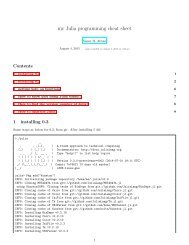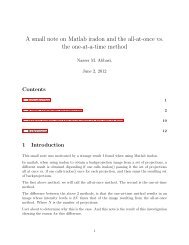You also want an ePaper? Increase the reach of your titles
YUMPU automatically turns print PDFs into web optimized ePapers that Google loves.
However, [Φ] −1 = [Φ] T [M] therefore<br />
{η} = [Φ] T [M] {x}<br />
⎧ ⎫ ⎡ ⎤<br />
⎨η 1 (t) ⎬ √µ1<br />
ϕ 11 √µ2<br />
ϕ 12<br />
⎩<br />
η 2 (t)<br />
⎭ = ⎣ ⎦<br />
õ1<br />
ϕ 21 √µ2<br />
ϕ 22<br />
⎤ ⎧ ⎫<br />
⎣ m 11 m 12<br />
⎨x ⎦ 1 (t) ⎬<br />
m 21 m<br />
⎩<br />
22 x 2 (t)<br />
⎭<br />
T ⎡<br />
The next step is to apply this transformation to the original equations of motion in order to decouple them<br />
1.6 Step 6, applying modal transformation to decouple the original equations of motion<br />
The EOM in normal coordinates is<br />
⎡<br />
⎣ m 11 m 12<br />
m 21<br />
⎤ ⎧<br />
⎨<br />
⎦<br />
m<br />
⎩<br />
22<br />
x ′′<br />
1<br />
x ′′<br />
2<br />
⎫ ⎡ ⎤ ⎧ ⎫ ⎧ ⎫<br />
⎬<br />
⎭ + ⎣ k 11 k 12<br />
⎨x ⎦ 1 ⎬ ⎨<br />
k<br />
⎩<br />
22 x<br />
⎭ = f 1 (t) ⎬<br />
⎩<br />
2 f 2 (t)<br />
⎭<br />
Applying the above modal transformation {x} = [Φ] {η} on the above results in<br />
⎡ ⎤ ⎧ ⎫ ⎡ ⎤ ⎧ ⎫ ⎧ ⎫<br />
⎣ m 11 m 12<br />
⎨η 1<br />
⎦ ′′ ⎬<br />
[Φ]<br />
m 21 m<br />
⎩<br />
22 η ′′ ⎭ + ⎣ k 11 k 12<br />
⎨η ⎦ 1 ⎬ ⎨<br />
[Φ]<br />
k 21 k<br />
⎩<br />
22 η<br />
⎭ = f 1 (t) ⎬<br />
⎩<br />
2 f 2 (t)<br />
⎭<br />
pre-multiplying by [Φ] T results in<br />
⎡ ⎤ ⎧<br />
[Φ] T ⎣ m 11 m 12<br />
⎨<br />
⎦ [Φ]<br />
m<br />
⎩<br />
22<br />
m 21<br />
η 1<br />
′′<br />
η 2<br />
′′<br />
2<br />
k 21<br />
⎫ ⎡ ⎤ ⎧ ⎫ ⎧ ⎫<br />
⎬<br />
⎭ + [Φ]T ⎣ k 11 k 12<br />
⎨η ⎦ 1 ⎬ ⎨<br />
[Φ]<br />
k<br />
⎩<br />
22 η<br />
⎭ = f 1 (t) ⎬<br />
[Φ]T ⎩<br />
2 f 2 (t)<br />
⎭<br />
⎡ ⎤<br />
⎡ ⎤<br />
The result of [Φ] T ⎣ m 11 m 12<br />
⎦ [Φ] will always be ⎣ 1 0 ⎦. This is because mass normalized shape vectors<br />
m 21 m 22 0 1<br />
are used. If the shape functions were not mass normalized, then the diagonal values will not be 1 as shown.<br />
⎡ ⎤<br />
⎡ ⎤<br />
The result of [Φ] T ⎣ k 11 k 12<br />
⎦ [Φ] will be ⎣ ω2 1 0<br />
⎦.<br />
k 21 k 22 0 ω2<br />
2<br />
⎧ ⎫ ⎧ ⎫<br />
⎨<br />
Let the result of [Φ] T f 1 (t) ⎬ ⎨ ˜f<br />
⎩<br />
f 2 (t)<br />
⎭ be 1 (t) ⎬<br />
,Therefore, in modal coordinates the original EOM becomes<br />
⎩ ˜f 2 (t)<br />
⎭<br />
⎡ ⎤ ⎧<br />
⎣ 1 0 ⎨<br />
⎦<br />
0 1<br />
⎩<br />
η 1<br />
′′<br />
η 2<br />
′′<br />
k 21<br />
⎫ ⎡ ⎤ ⎧ ⎫ ⎧ ⎫<br />
⎬<br />
⎭ + ⎣ ω2 1 0 ⎨η ⎦ 1 ⎬ ⎨ ˜f<br />
0 ω2<br />
2 ⎩<br />
η<br />
⎭ = 1 (t) ⎬<br />
⎩<br />
2<br />
˜f 2 (t)<br />
⎭<br />
The EOM are now decouples and each can be solved as follows<br />
η ′′<br />
1 (t) + ω 2 1η 1 (t) = ˜f 1 (t)<br />
η ′′<br />
2 (t) + ω 2 2η 2 (t) = ˜f 2 (t)<br />
To solve these EOM’s, the initial conditions in normal coordinates must be transformed to modal coordinates<br />
using the above transformation rules<br />
{η (0)} = [Φ] T [M] {x (0)}<br />
{<br />
η ′ (0) } = [Φ] T [M] { x ′ (0) }<br />
8





